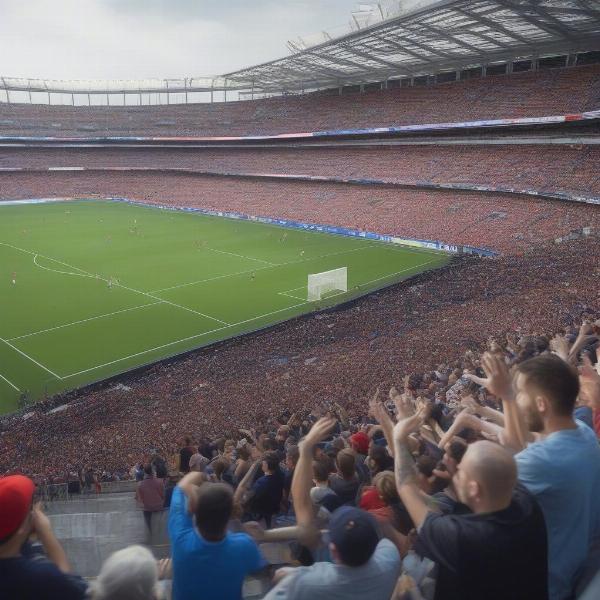A Major League Soccer (MLS) game typically lasts 90 minutes, divided into two 45-minute halves. However, due to stoppages for injuries, substitutions, and other delays, the actual time played often extends beyond 90 minutes. Understanding how this time breakdown works is key for any MLS fan.
Decoding MLS Game Time: More Than Just 90 Minutes
While the official game clock shows 90 minutes, the real-time experience of watching an MLS game is longer. This discrepancy between clock time and real time comes down to stoppage time, also known as injury time or added time. Let’s delve into the specifics of how this impacts the overall duration of an MLS match.
Understanding Stoppage Time in MLS
Stoppage time is added at the end of each half to compensate for time lost due to various interruptions. These interruptions can include:
- Injuries: Attending to injured players.
- Substitutions: The process of swapping players in and out.
- Goal Celebrations: The time taken for players to celebrate goals.
- Time Wasting: Deliberate attempts by players to slow down the game.
- VAR Reviews: Reviews by the Video Assistant Referee can significantly extend stoppage time.
The referee has the sole discretion to determine the amount of stoppage time added, and it can vary significantly from game to game.
Halftime Break
Between the two 45-minute halves, there is a 15-minute halftime break. This break allows players to rest and regroup, and coaches to make tactical adjustments. This intermission is a fixed period and doesn’t fluctuate based on game events.
 MLS Game Time Clock Displaying Stoppage Time
MLS Game Time Clock Displaying Stoppage Time
Factors Influencing MLS Game Duration
Several factors can influence the total duration of an MLS game. Understanding these variables can help viewers better manage their expectations when tuning in to watch a match.
The Referee’s Role
As mentioned, the referee plays a critical role in determining the amount of stoppage time. Some referees are known for adding more stoppage time than others, which can impact the final game length.
Style of Play
The way teams play also affects game duration. A fast-paced, attacking game with few interruptions might have less stoppage time. Conversely, a game with many fouls, injuries, and tactical substitutions will likely have more.
Game Importance
High-stakes games, such as playoffs or rivalry matches, tend to have more stoppages due to heightened intensity and strategic time management.
 MLS Referee Signaling Stoppage Time
MLS Referee Signaling Stoppage Time
How Does MLS Game Time Compare to Other Leagues?
MLS game time is broadly consistent with other major soccer leagues around the world, which also operate on a 90-minute plus stoppage time format. However, the average amount of stoppage time added can differ between leagues due to variations in playing styles and refereeing practices.
Comparing MLS to International Soccer
International soccer matches often have similar stoppage time patterns to MLS, though again, the referee’s interpretation of the rules plays a key role.
Youth and Amateur Games
Youth and amateur soccer games often have shorter halves, typically ranging from 20 to 45 minutes each, depending on the age group and league rules. Stoppage time is generally applied in these games as well, but the amounts tend to be shorter.
Planning Your MLS Viewing Experience
Knowing the intricacies of MLS game time can help fans plan their viewing experience more effectively. Here are a few tips:
- Allocate extra time: Don’t assume a game will end exactly at the 90-minute mark. Plan for at least an extra 15-20 minutes to account for stoppage time.
- Stay updated: Keep an eye on the on-screen graphics that display the added stoppage time to better gauge the remaining time in the match.
- Be prepared for delays: Understand that unexpected events can further extend the game time.
 MLS Fans Watching a Soccer Game
MLS Fans Watching a Soccer Game
Conclusion
So, how many minutes in an MLS soccer game? While the regulated time is 90 minutes plus a 15-minute halftime, the total time, including stoppage time, often stretches beyond 105 minutes. This dynamic timing adds to the excitement and unpredictability of MLS soccer. Being aware of the nuances of stoppage time and other influencing factors will undoubtedly enrich your MLS viewing experience. Now that you’re armed with this knowledge, grab your jersey, tune in, and enjoy the match!
FAQ
-
What is the average stoppage time in an MLS game? While it varies, stoppage time usually ranges from 2 to 6 minutes per half.
-
Is stoppage time the same as injury time? Yes, stoppage time and injury time are used interchangeably. They refer to the extra time added at the end of each half.
-
Who decides how much stoppage time is added? The referee has the sole discretion to determine the amount of stoppage time.
-
Does stoppage time include halftime? No, halftime is a separate 15-minute break between the two halves.
-
Are MLS games longer than games in other soccer leagues? Not necessarily. MLS game time is generally comparable to other professional soccer leagues around the world.
-
Do youth soccer games also have stoppage time? Yes, most youth soccer games include stoppage time, though the amount is typically less than in professional games.
-
Where can I find official MLS game time information? You can find official game times and details on the MLS website and app.

